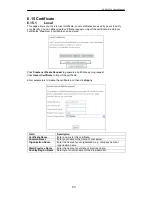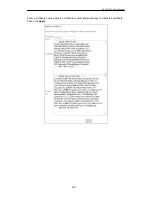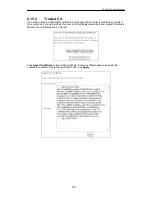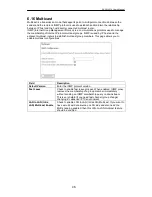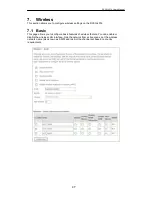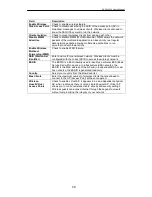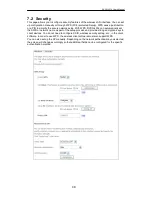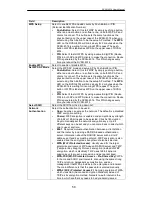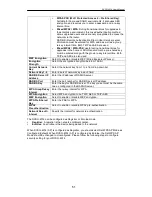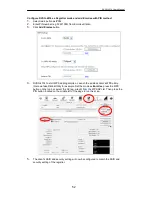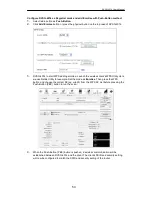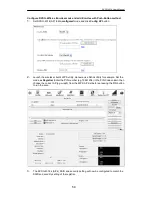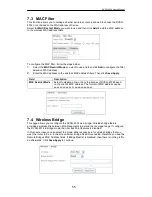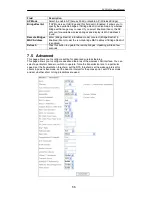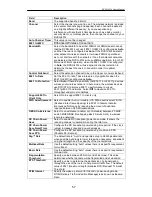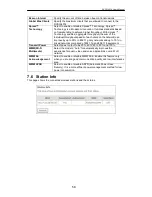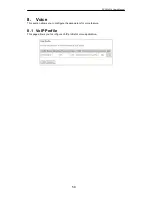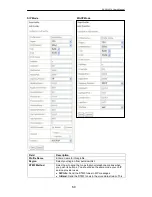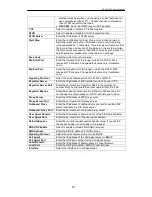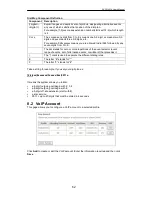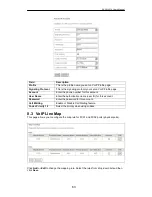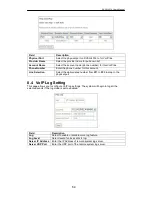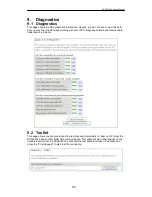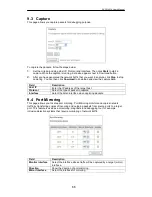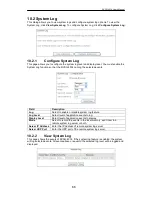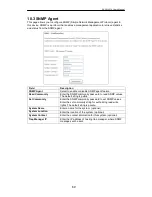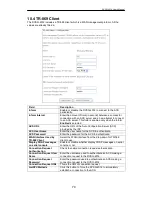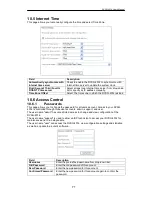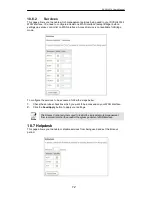
RVSG-4014 User’s Manual
57
Field
Description
Band
The supported band is 2.4GHz.
Channel
Select the channel you want to use. The wireless network is divided
into several channels (region depends). Each channel broadcasts
on a slightly different frequency; if you are experiencing
interference with another 2.4GHz device such as a baby monitor,
security alarm, or cordless phone, then change the channel on your
RVSG-4014.
Auto Channel Timer
This value cannot be changed.
802.11n/EWC
Enhanced Wireless Consortium
Bandwidth
Select the bandwidth to be either 20MHz or 40MHz (dual channel),
that the RVSG-4014 will use if 802.11n/EWC is configured as
Auto
and the Channel is configured as
Auto
. If the RVSG-4014 detects
other adjacent wireless networks, it will use 20 MHz operation so
as to not interfere with the networks. If no other adjacent networks
are detected, the RVSG-4014 will use 40MHz operation. In both 20
MHz and 40 MHz operation, when the 802.11n/EWC is configured
to
Auto
, the RVSG-4014 will use dynamic channel selection to
determine the best channels to transmit in order for optimal
operation.
Control Sideband
Select the extension channel to be in the Upper or Lower sideband.
802.11n Rate
Set the 802.11n rate. These rates are only applicable when the
802.11n/EWC is configured as
Auto
.
802.11n Protection
Select
Auto
if there is a possibility that 802.11b or 802.11g devices
will use your wireless network. In Auto mode, the wireless devices
use RTS/CTS to improve 802.11n performance in mixed
802.11g/802.11b networks. Select
Off
to maximize 802.11n
throughput under most conditions.
Support 802.11n
Client Only
Select On to support 802.11n clients only
RIFS Advertisement
Select to enable (Auto) or disable (Off) RIFS advertisement. RIFS
(Reduced Inter-frame Spacing) is a 802.11n feature that also
improves performance by reducing the amount of dead time
required between OFDM transmissions.
OBSS Co-Existence
Select to co-existence (enable) or not (disable) between 20 MHZ
and 40 MHZ OBSS (Overlapping Basic Service Sets) in wireless
local area networks.
RX Chain Power
Save
Select to enable RX (reception) power save mode. It allows the
reducing of power consumption during the idle time.
RX Chain Power
Save Quiet Time
Configure the RX (reception) power saving time period. If the clock
(value) increases, required power decreases.
RX Chain Power
Save PPS
Configure the RX (reception) power saving condition in PPS
(Packets Per Second).
54g™ Rate
The default rate is “Auto” and operates at up to 54 Mbps data rate
when possible but drops to lower rates when necessary, dependent
on signal strength and the capacity of the client stations.
Multicast Rate
Use the default setting “Auto” unless there is a specific requirement
for multicast.
Basic Rate
Use the default setting “Auto” unless there is a specific requirement
for basic rate.
Fragmentation
Threshold
Specify a value between 256 (min) and 2346 (max). This value
determines whether packets will be fragmented and at what size.
RTS Threshold
Specify a value to determine the packet size of a transmission
through the use of the router to help control traffic flow. The default
value of 2347 (maximum length) disables RTS (Request To Send)
Threshold.
DTIM Interval
Specify the wake-up interval for clients in power-saving mode.
DTIM (Delivery Traffic Indication Message) is as known as Beacon
Rate.
Summary of Contents for RVSG-4014
Page 24: ...RVSG 4014 User s Manual 21 ...
Page 44: ...RVSG 4014 User s Manual 41 ...

